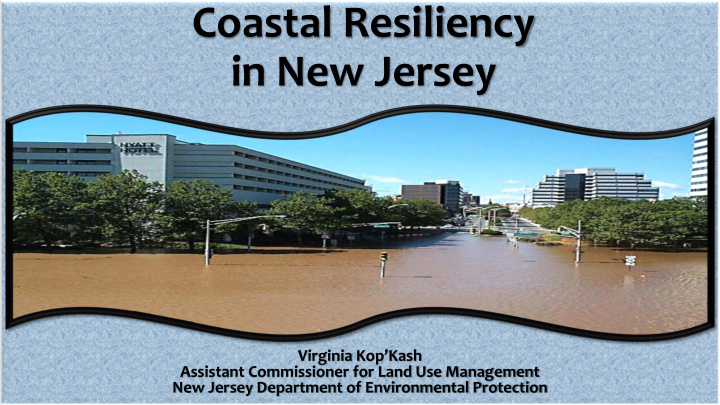



Coastal Resiliency in New Jersey Virginia Kop’Kash Assistant Commissioner for Land Use Management New Jersey Department of Environmental Protection
How Did We Get Here? ?
How Did We Get Here?
How Did We Get Here?
• New Jersey’s original settlements were along navigable waterways • As a result, many of the State’s population centers are within flood hazard areas today
How Did We Get Here?
How Did We Get Here?
How Did We Get Here?
How Did We Get Here?
What is Resiliency?
What is Resiliency? Resiliency ❖ Enhanced resiliency = effectively anticipating The ability to disasters and planning in advance to reduce prepare and plan for, disaster losses instead of merely coping with absorb, recover the aftermath of an event from, and more $ Complicated and expensive – requiring the successfully adapt to investment of time and resources prior to an event adverse events* *from Disaster Resilience: A National Imperative , National Academy of Science, 2012
Impacts of Superstorm Sandy Two million households in the state lost power 346,000 homes were damaged or destroyed Economic losses to businesses of up to $30 billion 37 people in NJ were killed
What is Resiliency? • Building Beaches and Dunes
• Building Sea Walls • Elevating Houses
• Retreating from Vulnerable Area s Blue Acres Program: • 935 offers made on homes in 14 municipalities • 714 offers accepted • 632 closings on homes in 14 municipalities • 531 demolitions completed
What are the Costs? • $375 million is currently committed for Blue Acres projects. Blue Acres has spent • $185 million from FEMA Hazard Mitigation Grant Program more than $172 million • $175 million from HUD Community Disaster Block Grant – Disaster Recovery on acquisitions to date. • $15 million from State bond funds Since Superstorm • $647 million spent on completed projects • Federal contribution = $605 million Sandy, $1.216 billion • New Jersey’s contribution = $42 million have been spent on • $569 million spent on projects currently under construction shore protection • Federal contribution = $490 million projects in New Jersey. • New Jersey’s contribution = $79 million
New Jersey’s Coast • 1,800 Miles of Tidal Coastline • 239 Municipalities • Inland, Seaward, Interstate • $16 Billion Annual Tourism • 1.5 Million Migratory Shorebirds • 50-Species Commercial Fishing
42% of New Jersey’s municipalities are coastal municipalities. http://www.nj.gov/dep/cmp/docs/new -detailed-cafra-map.pdf
Coastal Development
Coastal Hazards Coastal hazards include: These hazards threaten • Chronic flooding our coast, including the • Storm events of increasing population, infrastructure, intensity and frequency and habitat within our • Sea level rise coastal areas • Erosion
Flooding ❖ New Jersey endures severe and chronic flooding due to its: 1. Geography 2. Location along the eastern seaboard 3. High level of development • New Jersey is the most densely populated state in the nation. • Proximity to New York and Philadelphia increases the demand for development. • Development increases flooding.
Climate Change ❖ Flooding and storm events have been getting worse due to climate change. • The atmosphere is getting warmer. Warmer air holds more moisture, which results in increased flooding and larger storm events, such as Superstorm Sandy. • Sea levels are rising. • Land is subsiding.
Sea Level Rise • A sea level rise of 2 feet would affect or submerge about 1% of New Jersey’s land along the coastline. • This is projected to occur by 2100.
Recommend
More recommend